Chapter 3: Building a Quality E-Mail List
In This Chapter
![]() Getting your e-mail database ready
Getting your e-mail database ready
![]() Gathering valuable contact information
Gathering valuable contact information
![]() Attracting e-mail subscribers
Attracting e-mail subscribers
![]() Obtaining e-mail addresses through list brokers
Obtaining e-mail addresses through list brokers
Collecting e-mail addresses isn’t an easy task. Some people are so bothered by unsolicited e-mails that they’re willing to share almost anything else with you before they will share their e-mail addresses. Others might give you their e-mail addresses, but when the e-mails they receive from you don’t meet their expectations, they resort to unsubscribing or marking the e-mails as spam, even if they’re loyal customers.
This chapter guides you through some of the best tactics for building a permission-based e-mail list with a high number of quality subscribers. The chapter summarizes how and where to collect information, what information to collect, and how to prepare your database. A quality list helps ensure that your e-mail messages are received by the people who are most likely to respond with repeat and referral business.
You need to collect permission in addition to collecting contact information to send successful e-mails. If you need to collect permission, see Chapter 2 of this minibook.
Preparing Your E-Mail Database
Sending e-mails to your list requires your list data to be stored in a useful electronic format, so take care to enter your data into a database while you collect. Building and maintaining an electronic database allows you to
• Organize and view your list data easily.
• Sort your list data into categories to send targeted e-mails. For example, you might use your database to sort your data by ZIP code so that you can send a more targeted event invitation to a list of people in a specific ZIP code.
• Process and keep track of unsubscribed contacts.
• Query your list to extract useful information and reports.
Keep in mind that databases with a lot of complex features are more expensive than simpler applications. Make sure that any fancy functionality in your database can return more than a dollar for every dollar you spend to gain that function. You can always upgrade later when your e-mail marketing strategy outgrows your initial functionality.
Whether you use a well-known database application or a customized solution, most databases can export data in one or more compatible formats. Ask your EMP for a list of supported formats, and then check the export feature on your database to see whether you have a match. You can read more about what information to put in your database later in this chapter.
Figure 3-1: Using an EMP’s built-in database makes list management easy.
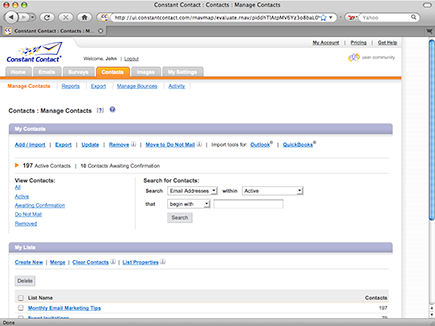
Courtesy of Constant Contact
Collecting Contact Information
The quality of your e-mail list depends greatly on where and how you collect the information in the first place as well as where and how you store and manage the data. The best way to ensure that you collect quality information is to obtain information and permission directly from the person who owns the information in the first place — namely, your prospects and customers.
Your challenge is to provide multiple opportunities and incentives for prospects and customers to share their information as well as to manage the resulting data effectively and efficiently.
If you already have a database of prospective e-mail list subscribers or if you have a lot of contact information from various sources waiting to be entered into a single database, flip to Chapter 2 of this minibook before adding those contacts to your e-mail list. There, you find information about inheriting a list.
Deciding what information to collect
Many businesses have been bought and sold based on the strength of the contact information they possess. Quality list data stored in a useful format is a goldmine for targeting your e-mail marketing messages and converting prospects and customers into steady streams of repeat and referral sales.
The two things you need to collect are an e-mail address and permission to send someone a professional e-mail. Generally speaking, enlisting subscribers is easier if you ask for as little information as possible. You’ll improve your results in the long run, however, if you make plans to gather increasing amounts of information over time — such as interests and personal information — as you interact with customers and prospects.
Table 3-1 lists several types of information you can ask prospective e-mail list subscribers for to help you build a valuable list.

• Sending short, relevant e-mail surveys
• Asking for information in the context of your regular e-mails
• Using forms and links on your website to collect information from people who are browsing or making purchases
• Asking for more information through other marketing media as more trust develops in your relationship
Getting to know your list members better
Believe it or not, most of your prospects aren’t interested in everything that you decide to send in the context of an e-mail strategy. When you collect contact information and permission, consider asking your prospective subscribers to share their interests. Using interest information allows you to sort your e-mail lists into categories and send information relevant to that category.
• Open-ended question: “Why do you dine with us?”
• Revised category-specific question: “Which answer best describes why you dine with us?”
• Money-saving offers
• New menu items
• Wine recommendations
• Live music and special events
• Priority, reserved event tickets
• Members-only discounts
• First-to-know product announcements
• Early-bird access to product-specific sales
Figure 3-2 shows a registration form that allows the reader to indicate a variety of interests.
Figure 3-2: Give your subscribers a selection of interest categories.

Don’t give your subscribers too many choices too early. Ask them to adjust their interests over time and collect information as you interact. You can also collect interest information without asking your subscribers by tracking their click behavior. For more about e-mail tracking, see Chapter 6 of this minibook.
Posting sign-up links online
Placing a sign-up link in every online presence possible is a great way to collect information with explicit permission. A sign-up link is a text box, button, or text that usually links to a sign-up form or a confirmation page that allows your subscriber to enter and submit additional information and preferences. Figure 3-3 shows three different types of sign-ups.
Figure 3-3: This website contains a text box, a button, and a text link.
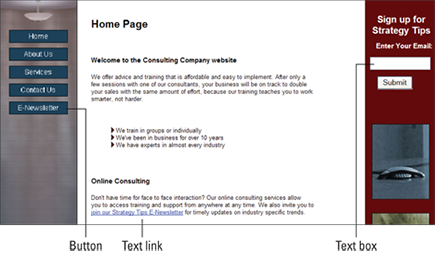
Some means of putting sign-up requests on a site include
• Text boxes: These allow your subscribers to enter information without clicking through to an additional sign-up form. Text boxes can ask for an e-mail address, or they can contain several fields making up an entire form.
• Buttons: These are graphical representations of links that take the subscriber to a form to complete and submit. Buttons can be images with text, flashing boxes, icons, or other creative graphics.
 A sign-up button should stand out, but don’t draw too much attention away from the content of your website for visitors who are already subscribers.
A sign-up button should stand out, but don’t draw too much attention away from the content of your website for visitors who are already subscribers.
• Text links: These are short headlines of plain text linked to a sign-up form. Text links are ideal if you want to add an option to subscribe within the context of other information or if you want to put a line of text in your e-mail signature.
• Check boxes: These are usually employed on multiuse forms to save additional steps. For example, someone who is making an online purchase already has to fill in her name and address, so adding a sign-up check box to the shipping form is a great way to gain permission to use the information for shipping the item and sending future e-mails.
 If you use check boxes, leave the box deselected (cleared) as the default setting because you don’t want people who overlook the box to become disgruntled when they receive future e-mails and feel that they were added to your list without their permission.
If you use check boxes, leave the box deselected (cleared) as the default setting because you don’t want people who overlook the box to become disgruntled when they receive future e-mails and feel that they were added to your list without their permission.
• Social applications: Social media sites such as Facebook allow applications to be added. You can build your own e-mail address collection applications, or you can use handy plug-ins built by your EMP, as shown in Figure 3-4.
Figure 3-4: Add a sign-up tab to your Facebook business Page using your EMP’s application.
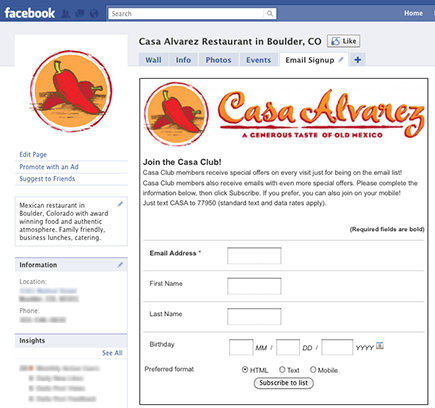
Courtesy of Casa Alvarez Mexican Restaurant
Whether you employ forms, buttons, text links, or any other element, experiment with different placement ideas. You can place a sign-up link almost anywhere that HTML (HyperText Markup Language) is possible. Try adding a sign-up link to the following locations:
• On every page of your website
• On social media sites
• In your e-mail signature, as shown in Figure 3-5
• On your blog or personal website: You can read more about blogs in Book VI.
• In banner ads and online advertising: You can read more about online advertising in Book IV.
• On other websites (with permission)
• In e-mails that your noncompeting colleagues send to their customers (with permission)
• In online directories
Figure 3-5: Place a sign-up link in your e-mail signature.

Collecting information through mobile devices
Mobile devices such as tablets and smartphones represent an opportunity to easily collect e-mail addresses on location. All the following methods of mobile e-mail address collection are worth using in your business.
Texting an e-mail address
Use your advertising to ask customers and prospects to text their e-mail address. Here are two ways to ask for e-mail addresses by text message:
• Ask people to text their e-mail addresses to your mobile phone number. If you don’t expect a lot of volume or can’t afford a short code or text-messaging platform, this method allows you to accept e-mail addresses from people on your mobile phone and add them to your address book so that you can send people e-mails. It’s highly manual, and you have to share or advertise your own mobile phone number, so use this method only if you can’t afford better technology.
• Ask people to text their e-mail addresses to your short code. A short code is a short phone number, usually four to six digits long. To enable this for your business, you need to buy or rent a short code, and then you need to make sure that your text-messaging application is set up to populate your database with e-mail addresses sent by text. If you have a dedicated short code — one that you own — you can ask people to text their e-mail addresses directly to your short code. Your platform’s database can automatically recognize the e-mail addresses and put that information in the proper database fields for you.
If you use a shared short code — one that you rent or share with other people — you need to ask people to include your keyword along with the e-mail address. For example, “text KEYWORD emailaddress to 12345,” where KEYWORD is your short code keyword, e-mailaddress is the subscriber’s e-mail address, and 12345 is your shared short code. (You can read more about short codes and keywords in Book VIII.)
Providing forms in mobile websites and apps
Your mobile website should include a sign-up form so that people can join your e-mail list from their mobile phones, as shown in Figure 3-6. List the domain name of your sign-up form in all your ads (for example, www.your company.com/sign-up). Keep your sign-up form short.
Figure 3-6: Make sure sign-up forms are formatted for mobile devices.
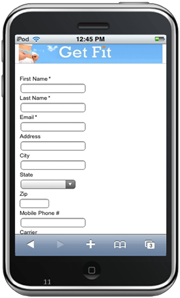
Courtesy of Constant Contact
You can use mobile websites and applications to collect e-mail addresses at
• Networking events, so that you don’t need to take a business card and type the info in later
• Trade shows, when you’re walking the floor or working your booth
• In your store, if you have a physical location and you interact in person
• In your office, during an appointment
Collecting information in person
According to the Ten Foot Rule, whenever anyone is within ten feet of you, ask for her contact information. A warm body or a verbal conversation can equate to a captive audience for communicating the benefits of joining your e-mail list.
Always ask for permission when you collect information in person. Here are some ways to connect and collect without being intrusive:
• Swap business cards.
 Ask whether that person’s preferred e-mail address is on the card.
Ask whether that person’s preferred e-mail address is on the card.
• Place a guest book on the counter in your store or office. Keep a tablet handy so that you can ask people anywhere to sign up on your website from anywhere.
• Place a basket for business cards on your table at trade shows and events. Make sure to place a sign on the basket that states your intent to send e-mails.
• Train your employees to take down customer information. Ask anyone who answers the phone at your business to ask for e-mail addresses and permission when customers and prospects call.
Collecting information through print
Adding sign-up information to direct mail and print advertising is a great way to help maximize your advertising dollars. You can use print to drive people to your website or store, you can ask them to fill out a paper form and return it, or you can ask them to send you an e-mail requesting to join the list.
Here are some ideas for using print to drive people to a sign-up process:
• Send a postcard offering an incentive (such as a free gift or an entry into a drawing) to return the card to the store with the recipient’s e-mail address filled in to a space on the card. Be sure to explain your intended usage and also ask permission in the text.
• Position your sign-up incentive to add value to your print offer. For example, you could print
Free child’s haircut with subscription to our preferred customer e-mail list.
• Add your sign-up incentive to the back of your business cards. For example, a discount store’s business card could include
Our e-mail list members save 10% more! Join online, in person, or by phone.
• Purchase an intuitive domain name and place it in your print advertising to promote sign-ups. In the preceding example, the discount store could purchase a domain such as www.JoinMyEmailList.com, and point it to the sign-up form on the company website.
Offering Incentives to Increase Sign-ups
Because your e-mail list is an asset — hopefully containing e-mail addresses belonging to loyal customers who spend more money as well as referral sources who love to tell others about you — offering an incentive in exchange for an e-mail subscription is really the least you can do to thank and reward your most valuable contacts.
Offering incentives for joining your e-mail list can reward your business in at least two ways:
• Increased sign-ups: The number of people willing to share their contact information with you is likely to increase if they feel that they’re getting something of value in return.
• Increased loyalty: An incentive rewards your subscribers and can cause loyalty, repeat business, and referrals to increase.
Giving subscribers immediate incentives
Some incentives, such as ongoing discounts, can be an inherent part of being on the list — and are, therefore, immediate upon the subscription. Immediate incentives abound and could include
• Discounts or reward points on every purchase
• VIP access to special events, front-row seats, and so on
• Access to members-only information
• Free trials, gifts, or additional services
Giving subscribers future incentives
Some incentives aren’t immediate but are instead forthcoming for members of the list. For example, imagine a clothing store that has a 48-hour sale twice per year, and only e-mail list subscribers are invited to save 50 percent if they order within the 48-hour period.
If e-mail list subscribers are the only customers invited to the event, the invitation is the incentive, but it isn’t immediate because the subscriber has to wait for an invitation to take advantage of the incentive.
Because the sale happens only twice per year, the store could send other e-mails between the sales with other offers and information. Imminent incentives are limited only by your own creativity and could include the following promotions:
• Early shopping hours during the holidays
• Invitations to periodic private events
• Random rewards, such as prize drawings
For example, asking potential subscribers to Sign Up for Friday Quick Tips tells them what to expect. Comparatively, asking a subscriber simply to Sign Up for Our E-Mail List is too generic and might cause prospective subscribers to hesitate — or, worse, disappoint subscribers when their expectations are not met.
Building a List with List Brokers
List brokers are marketing companies that collect and sell contact information. If you decide to build a list with the help of a list broker, recognize the significant differences between obtaining a list of physical addresses or phone numbers and obtaining e-mail addresses.
When you contact a reputable list broker to obtain e-mail addresses, the process isn’t as simple as selecting demographic information and paying to receive a data file because the e-mail addresses on a brokered list must, by law, be permission based.
Because the consumer ultimately decides what unwanted e-mail looks like, you can do everything right and end up with negative results. Furthermore, most EMPs discourage or disallow using rented lists and almost never allow using purchased lists.
Sticking to quality
Confirmed-permission lists are the only viable option for sending e-mails through list brokers. Confirmed-permission lists can be quite expensive because they are more difficult to obtain and because they contain e-mail addresses belonging to people who (at least for the moment) are interested in receiving specific types of information. You can expect to pay between 10 and 30 cents per e-mail address to send a single e-mail to a confirmed-permission list.
Confirmed-permission lists vary in quality, so remember to ask any broker some tough questions about the process used to obtain permission. The acid test of quality for a confirmed-permission list is whether the subscriber remembers opting in and also whether members of the list expect an e-mail from you as a result.
Make sure to clarify the following information, and use the responses to judge the likelihood of a memorable experience for the list subscriber:
• Where and how the e-mail addresses were obtained: Make sure that any online forms used to obtain the e-mail addresses ask for explicit permission to share the e-mail address as opposed to stating usage in a separate permission policy.
• When permission was confirmed: List subscribers might not remember opting in if permission was confirmed at the onset of the subscription and time has passed between the initial confirmation and the e-mail you intend to send. Ask the list broker to provide the opt-in date with any sample list or count.
• How interests were selected: Some list brokers make assumptions about their subscribers’ interests based on where the information is collected as opposed to brokers who actually ask subscribers to select or state their interests. For example, someone who fills out a survey and indicates that he loves live jazz music is a more valuable list subscriber than someone who purchases a jazz CD from a music website and fails to share whether he purchased it as a gift or was motivated by another interest. Make sure that interest information was supplied by the subscriber before paying an additional fee for an interest-based list.
Renting to own
Because quality confirmed-permission lists are so valuable, beware of supposed confirmed-permission lists for sale as a data file. Quality confirmed-permission lists are always rented out because the e-mail addresses are too valuable to sell.
As you might guess, list rental means that the list broker will never give you the e-mail addresses used to send your e-mail. Instead, you supply content to the list broker, and the list broker formats and sends your e-mail to the list.
Including a sign-up link asking recipients to subscribe to your personal e-mail list can make it possible to own the information provided by people who are interested but who aren’t ready to buy the moment they receive your brokered e-mail. If the list broker doesn’t allow a subscription link in the e-mail, make sure that any links in your brokered e-mail lead to a landing page that includes your sign-up box, button, or link.
If you can capture sales and information by using a rented list, make sure that your e-mails continue to meet or exceed all possible professional standards to help keep subscribers interested and happy to be on the list after they’ve confirmed.
For more information about e-mail professionalism standards and best practices, visit the Email Experience Council website at www.email experience.org.
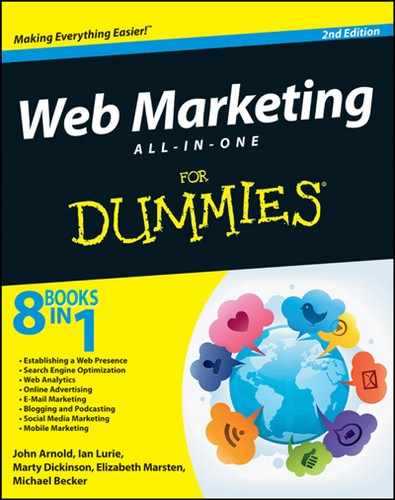
 The process of obtaining e-mail addresses from any list broker is full of potential pitfalls because consumers get annoyed by unsolicited mail. If the broker you choose doesn’t understand or adhere to permission laws and trends in the consumer landscape, sending e-mail to the list you obtain can damage your image and your future ability to send e-mail.
The process of obtaining e-mail addresses from any list broker is full of potential pitfalls because consumers get annoyed by unsolicited mail. If the broker you choose doesn’t understand or adhere to permission laws and trends in the consumer landscape, sending e-mail to the list you obtain can damage your image and your future ability to send e-mail.